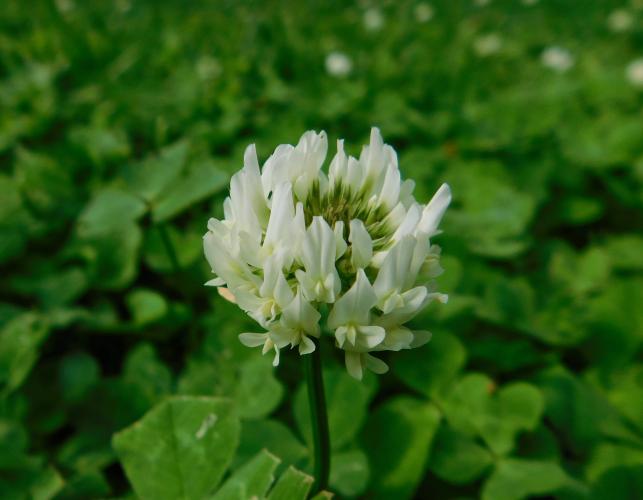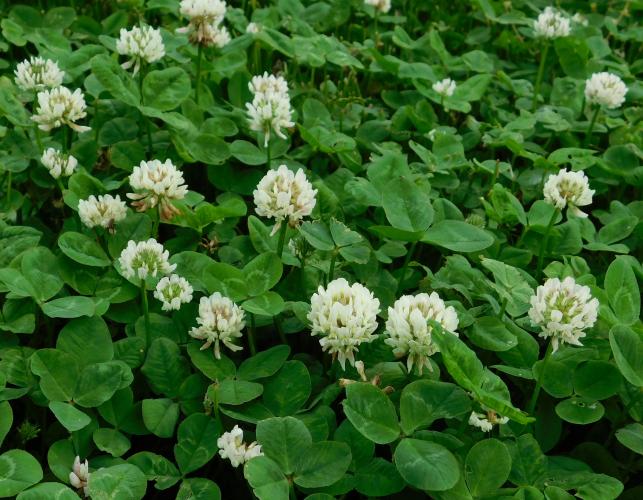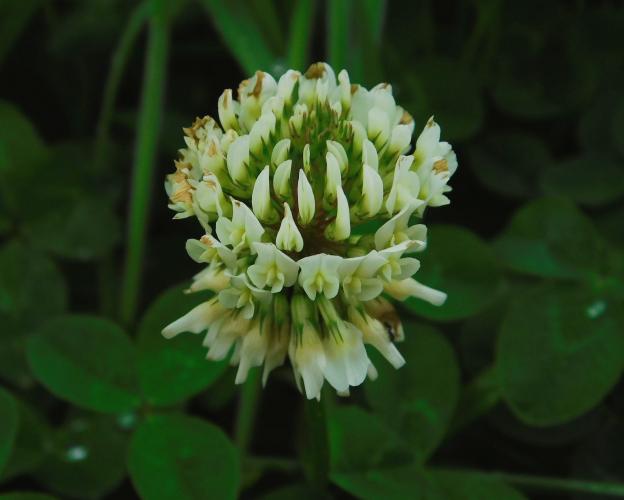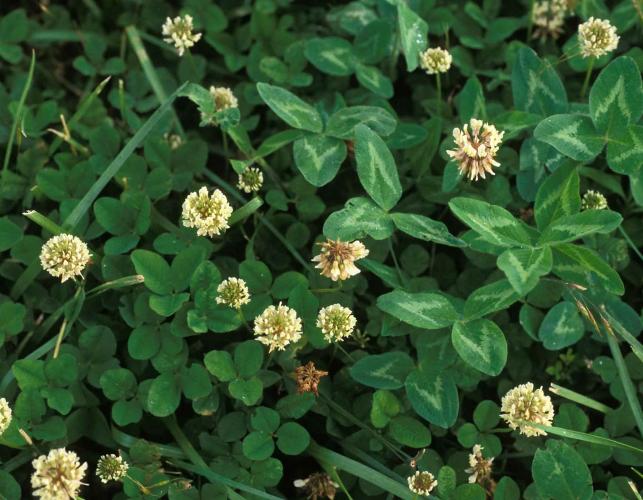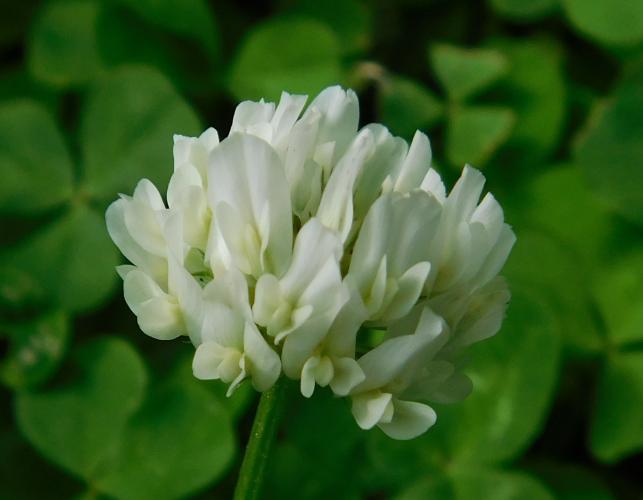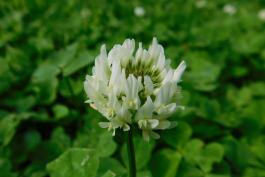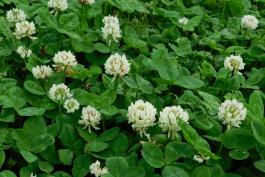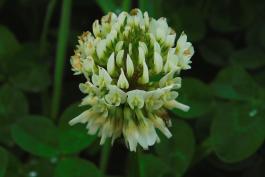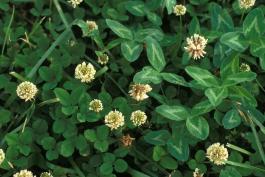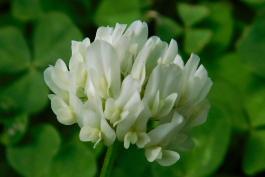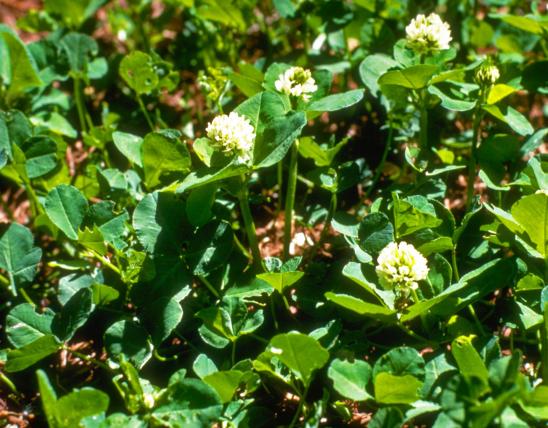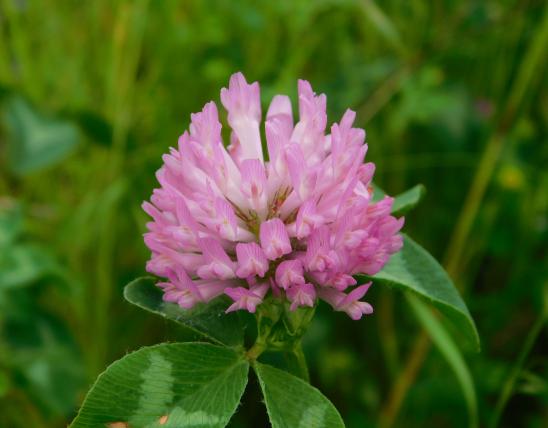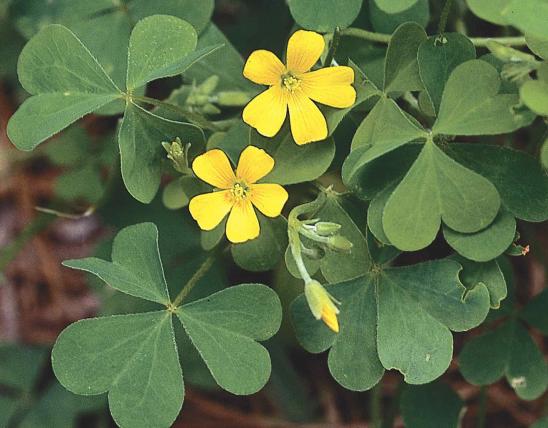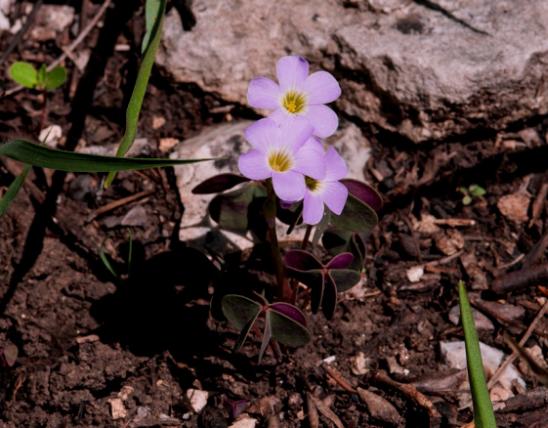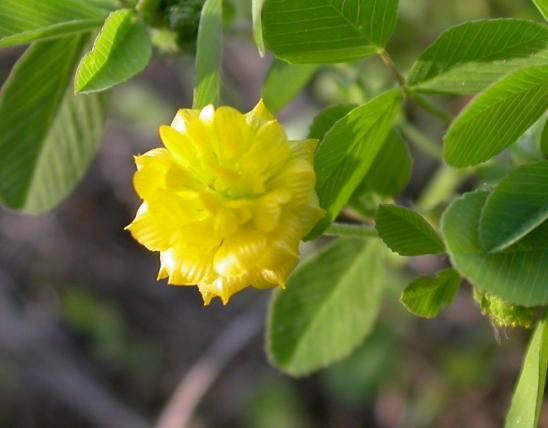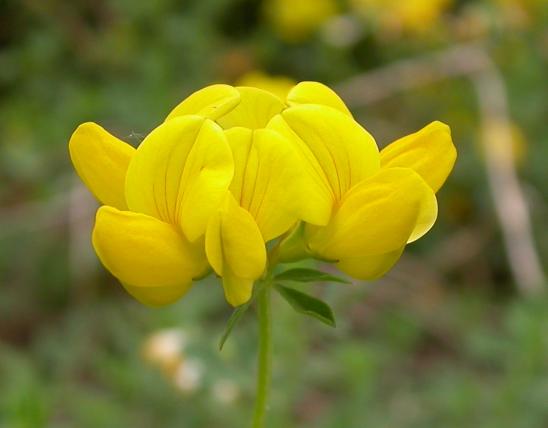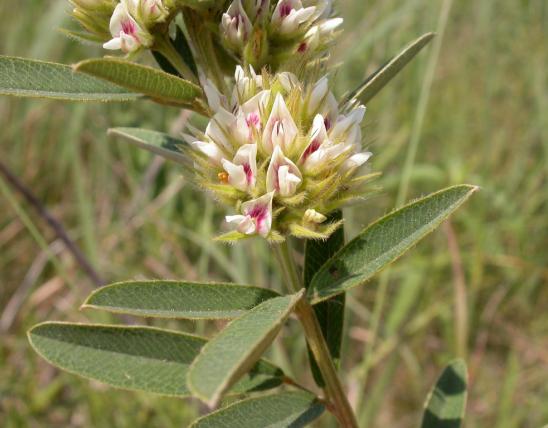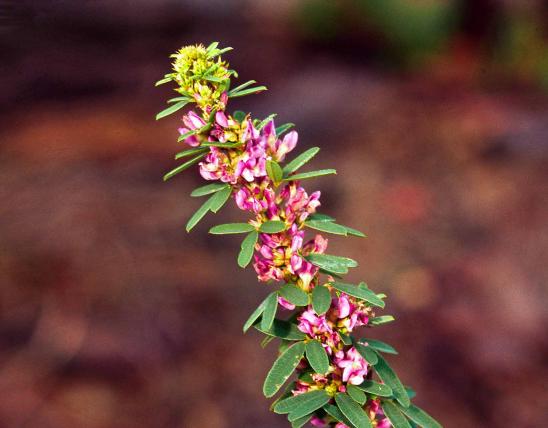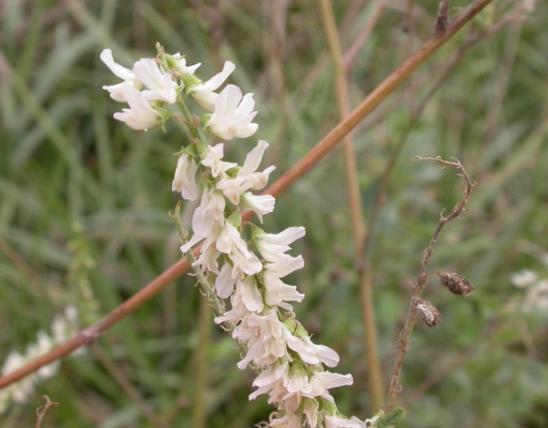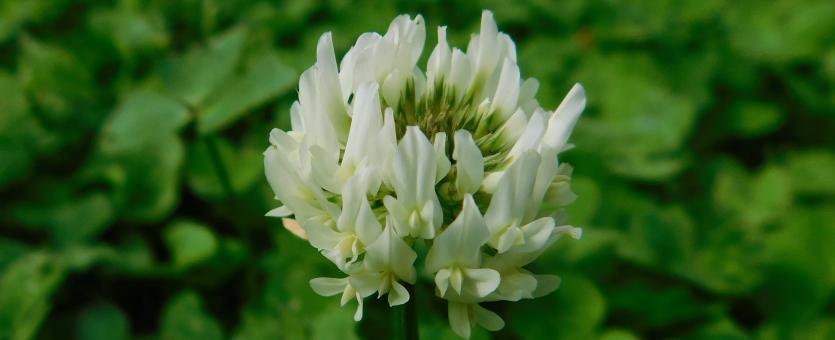
White clover is the familiar white-flowering clover that grows in lawns, pastures, and roadsides statewide. A Eurasian native, it was widespread in North America by the middle 1700s. What might surprise you is the fact that we have some other white-flowering clovers you haven’t heard of.
You probably know what white clover looks like, but you might not be aware of some fine points of its form. White clover is a perennial with fibrous roots and sometimes short rhizomes. The stems are prostrate and root at the nodes. Plants may be hairy or not. The leaf stems are usually rather long, sometimes up to 8 inches in length. The three leaflets that make up each leaf often have a pale crescent across the middle.
The rounded flower heads are about ½–1½ inches in diameter, on stalks 2–8 inches long; the stalks of the flower heads arise singly from the main prostrate stem, at the place where a leaf stem attaches. The flower head stalks don’t branch or have leaves or branches between the flower head and the main, prostrate stem. There is not a pair of leaflike bracts where the stems of the flower heads join the main stem. There are usually 20–50 florets per flower head. The calyxes (sepal tubes) are unequally toothed, often with dark purple around the V-shaped indentations. The petals are white to pinkish-tinged. Blooms March–November.
Similar species: Missouri has about 14 species in genus Trifolium. Some are rare and some are common; some are native and some were introduced. Several are yellow, red, or purple and therefore not likely to be confused with white clover. But we have a number of white-blooming clovers that could be confused with white clover:
- Alsike clover, or Alsatian or Swedish clover (T. hybridum), is an introduced European species scattered nearly statewide (least common in the Ozarks). It is a perennial growing from rhizomes, and the stems do not root at the nodes. It can grow to about 2 feet tall. The leaflets lack the pale crescent markings that are often seen on white clover’s leaflets. The flower heads are about ½–1 inch in diameter, with 20–80 florets per head. The calyxes (sepal tubes) are not hairy and stay green at maturity. The petals are white, becoming pinkish-tinged and then pink as they mature. Blooms May–October.
- Buffalo clover (T. reflexum) is a native widely scattered statewide, though absent from most of the Bootheel lowlands and much of the western portion of northern Missouri. It is an annual or biennial growing from a taproot, not rooting from the lower nodes. The stem is usually unbranched at the base and is loosely to strongly ascending, taller than white clover. Hairiness varies. The leaves attached to the base of the plant have relatively long stalks, while those toward the top are shorter. At the base of each leaf stalk is a pair of oval, pointed, leafy stipules that partially sheath the stem. Leaflets lack pale crescent markings. The flower heads are larger than those of white clover, about ¾–1½ inches in diameter, on stalks about ¾–2½ inch inches long, with 10–40 florets per head. The calyxes (sepal tubes) vary in hairiness and stay green at maturity. The petals are white to cream-colored or occasionally deep pink or pinkish-tinged, turning brown at maturity. The stalks of the florets bend over at maturity, giving the entire head a crowned appearance once the florets are spent. Blooms May–August. Populations of this species often appear at sites after a burn, heavy logging, or other disturbance, but if disturbance doesn’t continue, they usually disappear after a few years. The seeds remain in the soil, ready for the opportunity to arise again.
- Carolina clover (T. carolinianum) is an uncommon native species listed as a Missouri species of conservation concern. In our state, it is known only from an area of chert glades in Newton County and from historical collections in Boone and Jasper counties. It’s an annual growing from a taproot, and the stems do not root at the nodes. The flower heads are about ½–¾ inch in diameter, on stalks 2–4 inches long, with 5–40 florets per head. The calyxes (sepal tubes) are hairy and turn reddish at maturity, making the older flowers look purplish. The petals are creamy white to pinkish lavender and turn brown with age. Blooms March–June.
- Running buffalo clover (T. stoloniferum), a Missouri native, is a state endangered species (removed from the federal endangered list in 2021), usually growing on banks of spring branches, streams, and rivers in only a few locations in the southern half of the state. It used to be far more common. Like white clover, it is a perennial, with the main stems prostrate and rooting at the nodes. Unlike white clover, running buffalo clover has the stalks of the flower heads 1 or 2 (not just single), arising from a pair of bractlike leaves at the tip of an ascending branch that arises from the leaf axils of the main prostrate stem (meanwhile, the flower head stalks of white clover arise from the main prostrate stem singly, at the place where a leaf stem attaches but never as a stem bearing more than one flowerhead plus leaves together on a single stem, and never with leafy bracts at the juncture with the main stem). Blooms April–July.
- Red clover (or purple clover, T. pratense) — the common, well-known, perennial, introduced pasture and roadside plant with pinkish-purple flower heads — occasionally produces white flower heads, but these are larger than those of white clover, and the rest of the plant’s overall resemblance to the usual pinkish-purple versions of the species readily distinguish it from white clover. Blooms April–October.
Length: stems 4–15 inches.
Scattered to common statewide.
Habitat and Conservation
Occurs on banks of streams and rivers, margins of ponds, lakes, sinkhole ponds, and fens, and edges of bottomland forests; also in old fields, fallow fields, pastures, lawns, gardens, roadsides, and open, disturbed areas.
White clover is a native of Europe and Asia and has been introduced in temperate regions nearly worldwide, usually as a pasture plant.
Status
Introduced herbaceous perennial.
Human Connections
White clover spreads aggressively by its creeping stems. It is often considered a weed in lawns and gardens, and it has been declared an invasive plant in some U.S. states. It is not recommended for planting.
Worldwide, white clover may be the most important pasture plant in temperate regions. It was introduced to this continent so early, and it became so widely grown in North America, that Native Americans called it “white man’s foot grass.” It was widespread on this continent by the middle 1700s.
White clover, like other members of the bean family, has root nodules that can transform atmospheric nitrogen into a form that plants can use as fertilizer. This means that it can be used as a cover crop, green manure, companion plant, ground cover for lawns, and more, especially where soils are poor.
White clover is an important source for honey. The honeybee, like white clover, is native to Eurasia and not to North America.
Can you eat white clover? Apparently the leaves qualify as a survival food, but they are not considered tasty, nor are they easy to digest raw; thorough boiling seems to be the preferred way to prepare it as greens. People sometimes nibble on the fresh-blooming flower heads, or use them to make a tea.
Occasionally you may find white clovers that have leaves with 4 or 5 leaflets instead of 3. These are rare developmental abnormalities affecting individual leaves of plants otherwise possessing 3 leaflets per leaf. Four-leaf clovers have a very long history as symbols of good luck.
The so-called four-leaf clovers that are cultivated for sale are not related to true clovers. One of these is actually an aquatic fern called water clover or pepperwort (Marsilea quadrifolia). It’s a native of Europe that was introduced to North America and occurs in Missouri. Its leaves all have four leaflets; it grows in muddy bottoms of ponds and lakes; and the leaves sometimes emerge above the surface. It is sometimes grown as an aquarium plant.
There are several wood sorrels (Oxalis spp.) that are often sold as shamrocks. Purple-leaf shamrock or false shamrock (O. triangularis), a South American species, is a popular houseplant. Another wood sorrel, called iron cross plant, pink shamrock, or four-leaf clover, is a Mexican species of (O. deppei, also called O. tetraphylla). It is often sold by florists as a kind of four-leaf clover. The most familiar wood sorrel in Missouri is yellow wood sorrel, or sourgrass (O. stricta), a small yellow-flowering native plant common in lawns and gardens.
For centuries, the typical trifoliate clover leaf (trefoil) has been used as a symbol of the three-in-one concept of the Christian Trinity (Father, Son, and Holy Spirit). Look for stylized trefoils in the stained-glass windows and other architectural ornaments in older churches.
Ecosystem Connections
Bumblebees, honeybees, and other pollinators visit the flowers, including mason and cuckoo bees, certain types of flies, skippers, and butterflies such as the cabbage white. As a general rule, native plants are believed to be more nutritious and better-suited for our native pollinators than nonnative plants such as white clover.
Plenty of mammals eat the foliage and flowers of white clover: voles, rabbits, groundhogs, deer, bear, and others. Insects eat this plant, too, including certain types of leaf beetles, weevils, leaf-mining fly larvae, aphids, mealybugs, and plant bugs, and certain types of butterfly and moth caterpillars.
The seeds are eaten by northern bobwhite, grouse, horned lark, American robin, and several types of ducks.
It has been estimated that a white clover plant and its various branches usually can live for up to 20 years, but that some may survive for more than 100 years.
One researcher reported that nearly three-fourths of white clover seed was able to germinate even after being stored in an unheated shed for 25 years.
There are about 250 species in genus Trifolium worldwide. There are three subfamilies in the bean family (Fabaceae) (fah-BAY-cee-ee), and the clovers belong in subfamily Faboideae (fah-BOY-dee-ee), which have the pea-shaped flowers the bean family is known for. In the case of clovers, the pea-shaped flowers are small and clustered together into rounded heads. But if you look closely at each individual floret, you’ll see it has the same configuration of petals as in sweet peas, alfalfa, black locusts, peanuts, string beans, loco weeds, vetches, wild indigos, tick trefoils, wisterias, and more. Each flower has a broad banner (or standard) petal at the top, two side petals called wings, and two petals at the bottom that are usually fused into a boatlike keel. The unique form of these flowers makes them especially attractive to bees.
